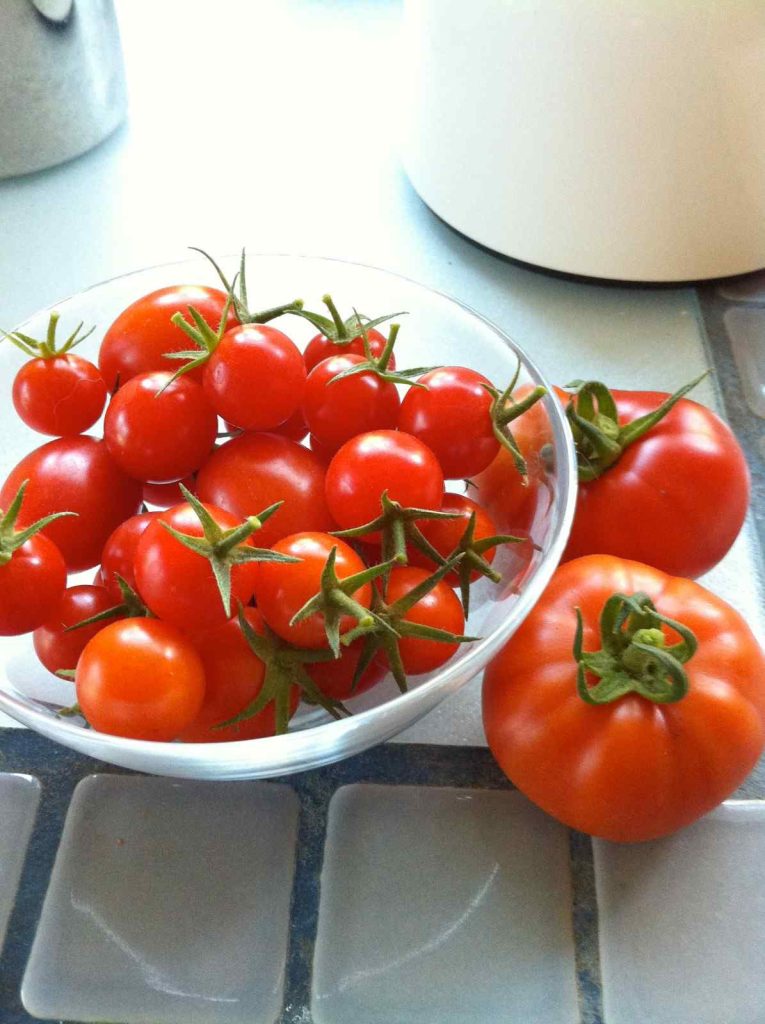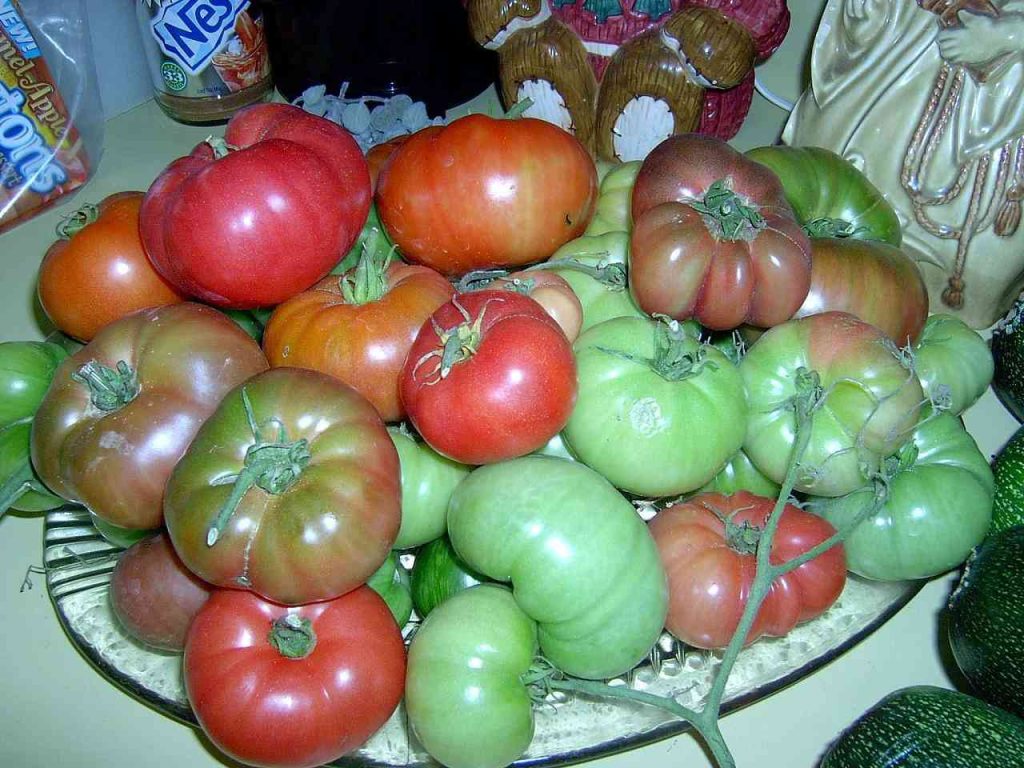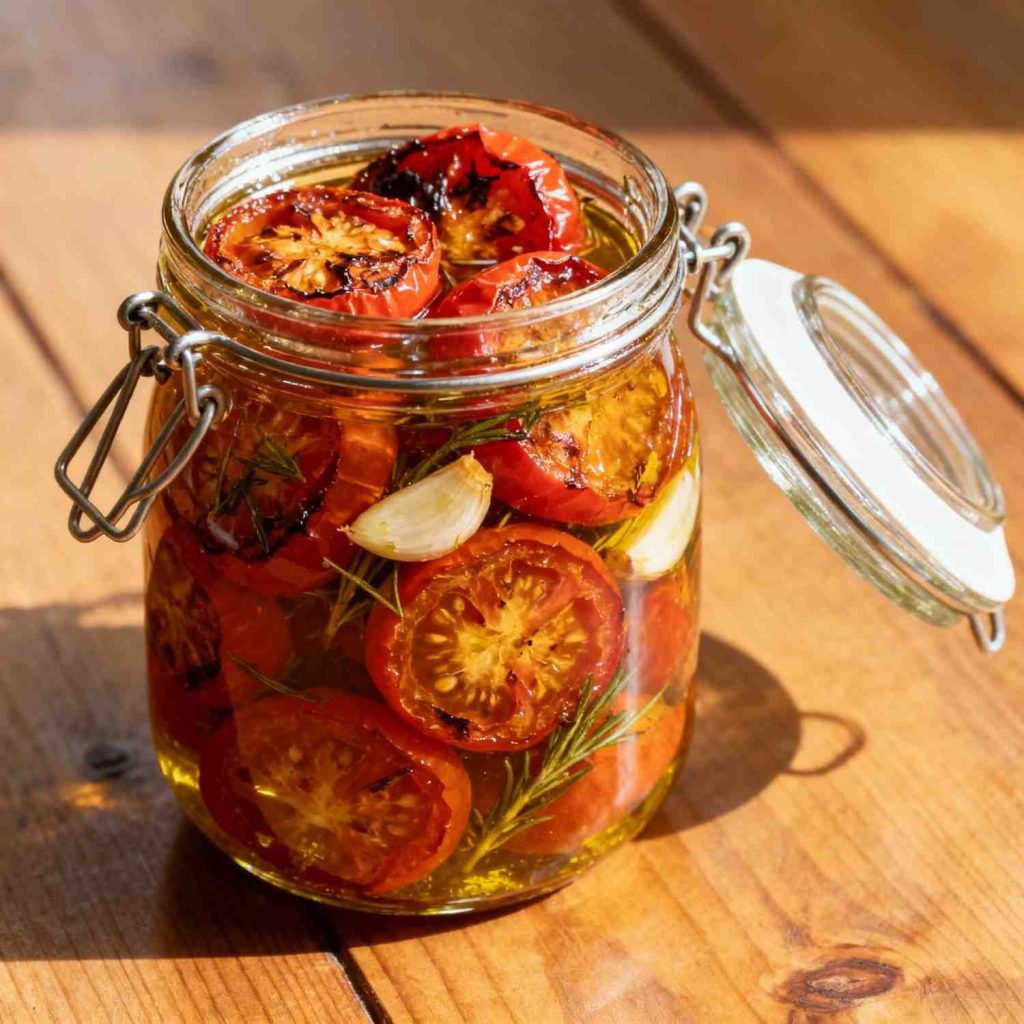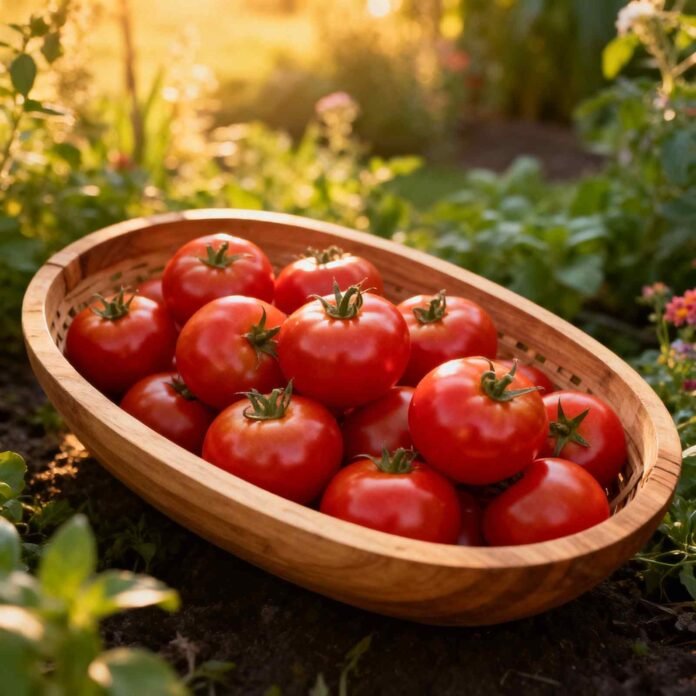Nothing can match the joy of pulling out a container to grab homegrown tomatoes and slice them for your recipe in the middle of winter. But that can’t be possible without keeping tomatoes fresh.
Now, the answer to how to store tomatoes from your garden isn’t straightforward. There are literally many ways to preserve them — canning, freezing, storing in olive oil, air-drying, and refrigerating. Eating right away when the tomatoes reach their peak is always the best way to enjoy that just-picked freshness.
But if you’ve grown more than you can eat, it’s smart to think ahead. One thing is clear: no method can completely capture the exact taste of a sun-warmed tomato fresh off the vine. Still, with a little care, you can hold onto that flavor and enjoy your harvest long after summer fades.
For short-term storage (not more than 7 days): place tomatoes upside down at room temperature between 55°F and 70°F.
For long-term storage: consider canning, dehydrating, freezing, or turning them into tomato puree.
When to Store Tomatoes?
Timing is everything when it comes to storage.
If your tomatoes are firm and just starting to turn color, leave them at room temperature for a few days until they fully ripen. Avoid the fridge at this stage — it dulls both the texture and the taste.
For tomatoes that are already ripe and you can’t use immediately, pick out the ones with no bruises or cracks. Gently wash and dry them. If you spot any overripe ones, set them aside to use right away in sauces or soups. The idea is to only store what’s in its best shape — bad ones can spoil the rest.
Choose Tomatoes at the Right Stage
Not all tomatoes are ideal for storing. Fully ripe, wrinkle-free ones work best for immediate use. If your plants are still producing and you want to extend their shelf life, pick tomatoes when they’re just starting to blush — that light pink stage before they fully ripen. These finish ripening beautifully indoors without losing their sweetness.
The ripening stages matter more than you’d think. A tomato picked at the breaker stage (when green starts turning whitish-yellow) will ripen slower but store longer. Roma and paste varieties generally store better than beefsteaks because of their thicker walls and lower moisture content.
Avoid tomatoes with cracks or bruises; they spoil quickly and can affect nearby ones. Always handle them gently, as a soft squeeze can leave unseen damage and invite mold later on. Check the stem end too—if it feels mushy or shows signs of darkening, that tomato won’t last long no matter which method you choose.
How to Store Tomatoes from Your Garden?

Let’s first start with by storing on the counter. Though for short-time, it is the best way to relish the freshness of tomato.
For a week or less, the kitchen counter is still the best place. Arrange your tomatoes stem-side down, so air doesn’t enter through the scar and cause early rotting. Keep them away from direct sunlight and heat sources, ideally at 55°F–70°F.
Never pile them up. A single layer works best so they can breathe evenly. If your kitchen gets too warm, choose a shaded corner or pantry shelf. Some gardeners place tomatoes in a shallow basket lined with cloth, which provides cushioning and allows air circulation from all sides.
Here’s a trick most people miss: separate tomatoes by ripeness level. Keep almost-ripe ones together and fully ripe ones separate. This way, you can grab the ready ones first without accidentally letting others over-ripen and turn soft.
If you notice a tomato starting to soften faster than expected, use it immediately in a salad or sandwich. One overripe tomato can release ethylene gas that speeds up ripening in others nearby.
Also Read: How to Can Green Beans with a Pressure Canner?
Refrigeration—When It’s Really Hot
Refrigerating tomatoes often sparks debate. Cold temperatures can make them lose flavor, but if your kitchen feels like a sauna, refrigeration might save them from rotting fast.
Place ripe tomatoes in the fridge only when necessary, ideally in the crisper drawer inside a paper bag. When ready to use, let them sit at room temperature for a few hours. This helps restore some of their natural texture and flavor.
The key is knowing when refrigeration makes sense. If temperatures climb above 75°F consistently, refrigerating becomes the lesser evil compared to watching them turn mushy within two days. Just remember to bring them back to room temperature before eating raw—cold tomatoes taste bland and mealy.
For cherry and grape tomatoes, refrigeration works slightly better since they’re often used in cooked dishes anyway. Store them unwashed in a breathable container, and they’ll hold up for nearly two weeks.
Freezing Tomatoes for Later
Freezing is perfect when your harvest overflows. You can freeze tomatoes whole, chopped, or pureed—it depends on how you plan to use them later.
Wash and dry them thoroughly. Remove stems and cores. You can blanch them in boiling water for 30 seconds if you’d like to remove skins easily—the skins will slip right off after a quick ice bath. For whole tomatoes, spread them on a baking sheet first and freeze until solid, then transfer to bags. This prevents them from clumping together.
Pack them into airtight freezer-safe bags or containers, leaving some space at the top. Label each bag with the date and variety if you’re freezing different types. Frozen tomatoes lose their firm texture but are great for sauces, soups, and stews. They last up to 8 months in the freezer.
When you need them, pull out however many you want and run them under warm water—the skins slide off effortlessly. Toss them directly into simmering pots without thawing. The texture won’t work for fresh salads, but for cooked dishes, they’re nearly as good as fresh.
Canning Tomatoes for Year-Long Preservation

Canning preserves tomatoes for months without losing too much flavor. It requires a bit of effort but pays off all winter.
First, sterilize your jars and lids by boiling them for 10 minutes. Peel and chop the tomatoes, or leave them whole if you prefer. For easier peeling, score an X on the bottom of each tomato, blanch for 30 seconds, then plunge into ice water.
Add lemon juice or citric acid for acidity and safe storage—this step isn’t optional, especially with modern low-acid tomato varieties. Use 2 tablespoons of bottled lemon juice per quart jar or 1 tablespoon per pint. Fill jars with tomatoes and seal tightly, leaving half an inch of headspace.
Process them in a hot water bath for the recommended time depending on altitude. At sea level, pints need 40 minutes and quarts need 45 minutes. Higher altitudes require longer processing times to ensure safety.
Properly canned tomatoes can last up to a year in a cool, dark pantry. Check seals after 24 hours—the lids should curve downward and shouldn’t flex when pressed. Any jar that didn’t seal properly should go straight into the fridge and be used within a week.
Making Tomato Puree or Sauce
If you cook often, turning extra tomatoes into puree or sauce is practical. The flavor concentrates as it cooks down, and you can season it lightly or keep it plain for later.
Simmer chopped tomatoes until thick, blend if needed, and cool completely before freezing or canning. For a richer sauce, roast tomatoes with garlic and onions first—the caramelization adds incredible depth. Puree stores well in small portions, ready to add directly into curries, soups, or pasta dishes.
Ice cube trays work brilliantly for portion control. Freeze tomato puree in trays, then pop out the cubes and store them in freezer bags. Each cube equals roughly two tablespoons, perfect for adding to single-serving meals.
If canning sauce, remember it needs to be processed longer than whole tomatoes because of its thickness. Follow tested recipes from reliable sources like the USDA or Ball canning guides to avoid food safety issues.
Also Read: How Do You Dry Rosemary Leaves?
Drying Tomatoes
Sun-drying or using a dehydrator can turn extra tomatoes into flavorful bites you can later rehydrate or blend into cooking.
Slice tomatoes thinly, about quarter-inch thick. Sprinkle lightly with salt, and dry them under the sun covered with mesh—this may take a few days depending on humidity and temperature. Choose a spot with good airflow and bring them inside at night to avoid moisture from dew.
If using an oven, set it at 135°F–150°F (57°C–66°C) and dry slowly until leathery but not brittle. Prop the oven door open slightly with a wooden spoon to let moisture escape. Flip slices halfway through for even drying.
Store dried tomatoes in airtight jars with olive oil for an incredible flavor boost. Add herbs like basil or oregano, and maybe a clove of garlic. They’ll keep for months in the fridge and make pasta dishes sing with minimal effort.
For grinding into tomato powder, dry them until completely crispy, then pulse in a food processor. The powder works as a flavor enhancer in soups, stews, and even popcorn seasoning.
Storing Green Tomatoes from Your Garden

Have unripe green tomatoes at season-end? Wrap each in newspaper and store in a single layer in a box or basket. Keep it in a cool spot (around 55°F). Check every few days—some will ripen gradually, letting you enjoy a slow trickle of fresh tomatoes even after frost sets in.
Not all green tomatoes will ripen, though. Mature green tomatoes (full-sized but not yet colored) have the best chance. Tiny ones that never developed fully will likely just shrivel.
Adding a ripe banana or apple to the box speeds up ripening by releasing ethylene gas. Remove any that show rot immediately to protect the others. Some gardeners prefer pulling entire plants and hanging them upside down in a garage—the tomatoes ripen slowly while still attached.
You can also pickle green tomatoes or fry them for a tangy treat. They have a firm texture and tart flavor that works beautifully in Southern-style dishes.
Must Read: How to Store Carrots from the Garden?
How to Store Tomatoes in Olive Oil?

This method doesn’t get talked about enough. Roast halved tomatoes with olive oil, garlic, and herbs until slightly caramelized. Pack them in sterilized jars and cover completely with olive oil. The oil preserves them while infusing with tomato flavor.
Store these jars in the refrigerator for up to two weeks. Use the tomatoes in sandwiches, pasta, or bruschetta. The flavored oil becomes a bonus ingredient for salad dressings and sautéing vegetables.
Tips and Common Mistakes to Avoid
Never wash tomatoes before storing unless you’re using them immediately. Moisture invites mold and shortens shelf life dramatically.
Don’t store tomatoes with vegetables that release lots of ethylene gas, like potatoes or onions, unless you want them to ripen faster.
Avoid plastic bags for counter storage—they trap moisture and create the perfect environment for rot. Breathable containers or open baskets work better.
For canning, always use tested recipes with proper acid levels. Experimenting with low-acid ingredients can lead to botulism, which is dangerous and preventable.
When freezing, squeeze out excess air from bags before sealing. Less air means less freezer burn and better flavor retention.
Conclusion
There’s no one-size-fits-all method when it comes to storing tomatoes from your garden. It depends on how long you want to keep them and how you plan to use them later. For quick meals, freezing works great. For year-round use, canning is unbeatable. If you want something gourmet, preserve them in olive oil or dry them for an intense, concentrated flavor.
The key is to handle your tomatoes gently and give them the care they deserve. With a bit of prep, you can enjoy the taste of your summer garden even when snow covers the ground. Because honestly, few things taste better than that first spoonful of homemade tomato sauce in the middle of winter — straight from your own harvest.

Khaja Moinuddin, a computer science graduate, finds joy in gardening and homesteading. Join him on this blog as he shares his experiences in homesteading, gardening, and composting


